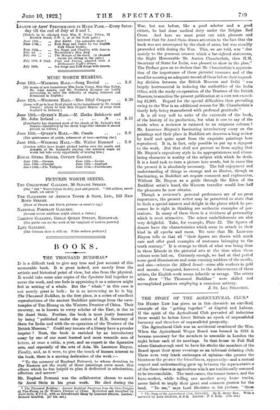BOOKS.
1.HE THOUSAND BUDDHAS.* IT is a difficult task to give any true and just account of this memorable book. It is great indeed, not merely from the
artistic and historical point of view, but also from the physical. It would take some nine copies of the Spectator laid together to cover the work, and one feels in appraising it as a minnow might feel in writing of a whale. But the " whale " in this case is not merely great in bulk : he is as interesting as he is big. The Thousand' Buddhas, in the first place, is a series of excellent reproductions of the ancient Buddhist, paintings from the cave-
temples of Tun-Huang on the Western Frontier of China. Their recovery, as is known to every scholar of the. East, is due to Sir. Aural Stein. Further, the book, is most justly honoured by being " published under the orders of. H.M. Secretary of State for India and with the-co-operation of the Trustees of the British. Museum." Could:any inmate of &library have a prouder imprint ? Next, the book is enriched by an introductory essay by one' of our most learned and most versatile men. of letters, at once a critic, a poet, and an expert in the figurative arts, and especially of the arts of. Asia, Mn Laurence Binyon.
Finally, and, as it were, to give the touch of human interest to the- book, there- is a, moving dedication of the work:— " To the memory of Raphael Petrucci, to whose devotion to Far Eastern art- the study of these- paintings owes most, this album which he-has helped to plan is dedicated in admiration; affliction and sorrow."
Pllt, Raphael Petrucci was the oollaberator chosen to' assist Sir Aural. Stein in his great work. He died during the • The Thousand Buddhas : Ancient Buddhist Paintings from the Cave-Temples of, Tun-Mang on the Western Frontier of. China. Recovered and deacribed: by Muni Stein, KZ:I.E., with an Introductory Essay by Laurence Mayon. rondos: Bernard (Bleach. [27 lbs. net.]
War, but not before, like a good soholar and a good citizen, he had done medical duty under the Belgian Red Cross. And here we must point out with pleasure and interest that Sir Aurel Stein draws attention to the fact that the book was not interrupted by the clash of arms, but was steadily proceeded with during the War. This, we are told, was " due mainly to the generous interest which a far-sighted statesman, the Right Honourable Mr. Austen Chamberlain, then H.M. Secretary of State for India, was pleased to show in the plan." The Preface goes on to declare that Mr. Chamberlain's apprecia- tion of the importance of these pictorial treasures and of the need for securing an adequate record of them before their impend- ing division between the British Museum and Delhi " was largely instrumental in inducing the authorities of tho India Office, with the ready co-operation of the Trustees of the British Museum, to sanction the present publication at a cost not exceed- ing £1,900. Regard for the special difficulties then prevailing owing to the War is an additional reason for Mr. Chamberlain's timely help being remembered with profound gratitude."
It is all very well to write of the externals of the book, of the history of its production, but what is one to say of the inside when a reviewer is rationed to an exiguous column ? Mr. Laurence Binyon's fascinating introductory essay on the paintings and their place in Buddhist art deserves a long review by itself and quite apart from the exquisite paintings hero reproduced. It is, in fact, only possible to put up a signpost to the work. But that shall not prevent us from saying that Mr. Binyon's expository style in its appropriateness and stimu- lating character is worthy of the subject with which he deals. It is a hard task to turn a picture into words, but in cases like the present it is absolutely necessary. The full enjoyment and understanding of things so strange and so illusive, though so fascinating, as Buddhist art require comment and explanation. Without Mr. Binyon as a guide through the Eden of the Buddhist artist's hand, the Western traveller would lose half the pleasures he now obtains.
Though a reviewer's personal preferences are of no great importance, the present writer may be permitted to state that he finds a special interest and delight in the plates which he pre- sumes he is right in thinking are authentic examples of por- traiture. In many of them there is a vividness elf personality which is most attractive. The minor embellishments are also very delightful. Take, for example, Plate 22. The figures of donors have the characteristics which seem to attach to their kind in all epochs and races. We note that Mr. Laurence Binyon tells us that all " their, figures are drawn with much care and offer good examples of costumes belonging to the tenth century." It is strange to think of what was being done in these Islands in. the pictorial arts at the timo when these colours were laid on. Curiously enough, we had at that period some good illuminators and some cunning wielders of the needle, and also—witness the Alfred Jewel—some able workers in gold and mosaic. Compared, however, to the achievements of these artists, the English work seems infantile or savage. The artists who drew " The Thousand Buddhas " were skilled and accomplished painters employing a conscious artistry.
J. ST. LOE STRACHEY.


































 Previous page
Previous page